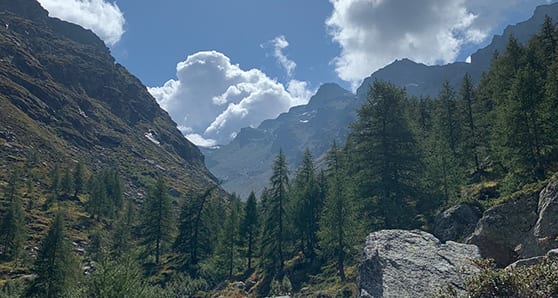 Newly retired and eager to explore some new territory, I admit I knew nothing of the Italian Alps.
Newly retired and eager to explore some new territory, I admit I knew nothing of the Italian Alps.
We flew into Switzerland, and then drove south through the 11-plus km of the Mont Blanc Tunnel into northern Italy. We were with old friends who know the area well because they have a son who lives in Geneva.
And so began a new adventure with maps and guidebooks portraying the northwest corner of Italy, on shared borders with Switzerland to the north and France to the west.
No sooner did we exit our rented Citroen in the village of Courmayeur than a patois of Italian, French and occasional English characterized signage, our restaurant conversations, and the general ambience of this high-altitude world.
Clearly, this was not Florence or Rome.
But there was immediately much more for the retired anthropologist to observe.
At our first lunch in an Italian Alps restaurant, our table was surrounded by others filled with Italian men and women wearing bright yellow competition T-shirts advertising trail running events and their corporate sponsors. All were ultra-fit. I especially noted how thin and trim their body cores were compared to mine. I also noted that many were still wearing a life-jacket-like vests that contained a water bag and plastic drinking pipes positioned just below their mouths.
Clearly we were in a mountain culture that normalized the ‘Grouse Grind’ routine of our Vancouver home, but generalized it across a much broader population of aficionados. Here you stood out if you weren’t astonishingly fit.
We ended our first day in Cogne, a lyrical mountain village in the Parco Nazionale Gran Paradiso. To us Canadians, it suggested Jasper in the Rockies, but with a thriving valley culture of cattle ranching and sheep herding.
On the Saturday we arrived, the annual autumn Bataille de Reines (Battle of the Queens) was just finishing. It sees local cattlemen and women bring their most dominant cow (not steer), to a fenced alpine meadow where a day of competition leads to the crowning of the Queen of Cogne, the dominant cow of the Aosta Valley.
For the next four days, we hiked to our heart’s content in the Valnontey River region to the south of Cogne. Our first hike covered 10 km (or about 17,000 steps) and 140 floors (or 452 metres) of altitude gain. We accomplished the up and down in about four hours, not terribly bad, I wishfully speculate, for late-60s Canadians.
(The Vancouver-area Grouse Grind is an 850-metre climb over 2.8 km, and a one-hour up-only completion time commands respect.)
But we were continuously passed by various family groupings of Italians, who appeared intent on running up the trail. And then briefly lunching before running down, aided by spring-loaded hiking poles. Every group sang out “buongiorno” as they passed.
When we occasionally met for longer periods at spring-fed water fountains on the trail, it was clear that French and some English conversations were also on offer. The shared borders with France and Switzerland have clearly contributed to a multilingual society in this very northern corner of Italy.
In Cogne each night, we dined in a restaurants specializing in northern Italian cooking, and featuring the local harvest of game (predominantly roe deer and lake trout), vegetables, salads and porcini mushrooms that had just been picked.
One of our servers somewhat gleefully asked if we wanted “local or Italian wine?” Clearly we were in another world – one where local was the standard of excellence.
In our second week, we headed west and set up house in an Airbnb suite in the small mountain village of Bien, in the Valsavarenche comune of the Val d’Aosta.
Here we continued our hiking forays and we continued to meet more Italians in the backcountry than any other nationality.
At times I felt we were the only party of out-of-country tourists in the valley. Everyone we saw on the trails expressed a friendly greeting and one fellow went so far as to ask, in English, “What country are you from?”
When I said we were Canadian, he told me that Italians often referred to this part of their country as “mini Canada.” It was easy to agree with the observation.
Mike Robinson has been CEO of three Canadian NGOs: the Arctic Institute of North America, the Glenbow Museum and the Bill Reid Gallery. Mike has chaired the national boards of Friends of the Earth, the David Suzuki Foundation, and the Canadian Parks and Wilderness Society. In 2004, he became a Member of the Order of Canada.
BECOME A TRAVEL LIKE THIS CONTRIBUTOR. Contact us for details.
The views, opinions and positions expressed by columnists and contributors are the author’s alone. They do not inherently or expressly reflect the views, opinions and/or positions of our publication.






